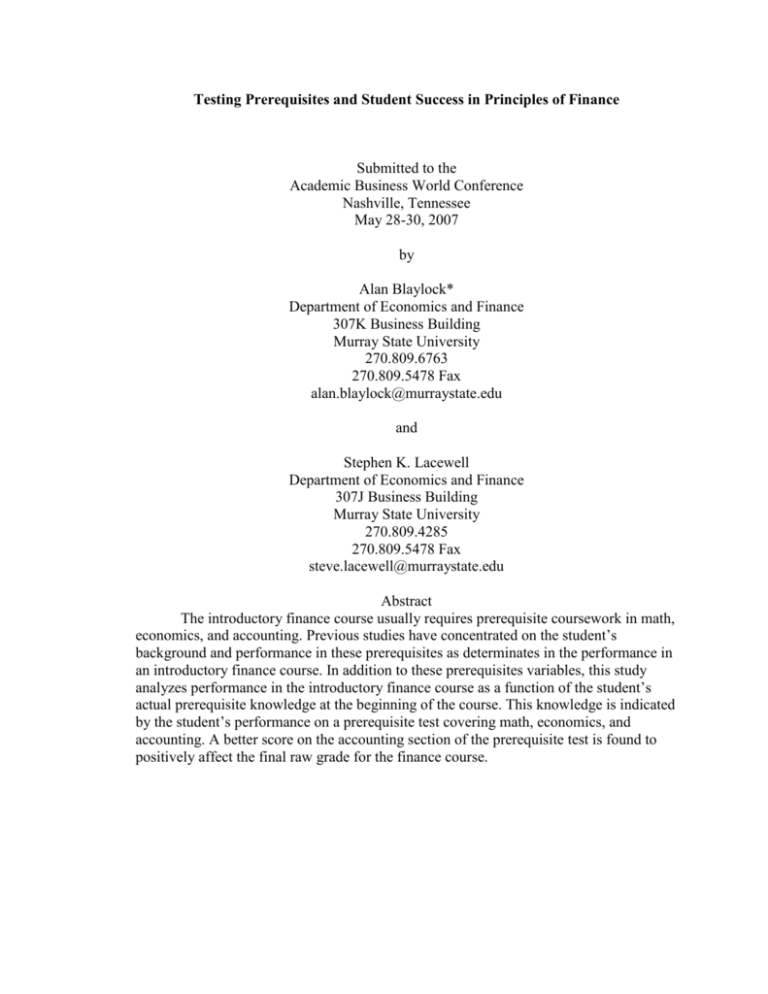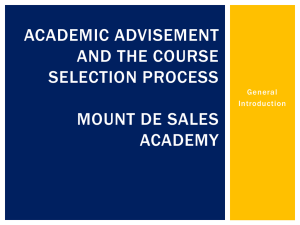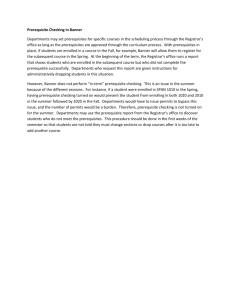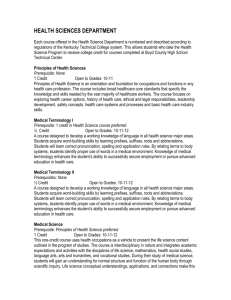Most principles classes of all disciplines have few, if any, formal
advertisement

Testing Prerequisites and Student Success in Principles of Finance Submitted to the Academic Business World Conference Nashville, Tennessee May 28-30, 2007 by Alan Blaylock* Department of Economics and Finance 307K Business Building Murray State University 270.809.6763 270.809.5478 Fax alan.blaylock@murraystate.edu and Stephen K. Lacewell Department of Economics and Finance 307J Business Building Murray State University 270.809.4285 270.809.5478 Fax steve.lacewell@murraystate.edu Abstract The introductory finance course usually requires prerequisite coursework in math, economics, and accounting. Previous studies have concentrated on the student’s background and performance in these prerequisites as determinates in the performance in an introductory finance course. In addition to these prerequisites variables, this study analyzes performance in the introductory finance course as a function of the student’s actual prerequisite knowledge at the beginning of the course. This knowledge is indicated by the student’s performance on a prerequisite test covering math, economics, and accounting. A better score on the accounting section of the prerequisite test is found to positively affect the final raw grade for the finance course. Testing Prerequisites and Student Success in Principles of Finance While most business schools require prerequisite knowledge in the areas of math, economics, and accounting for the introductory finance course, little evidence points to which, if any, of these prerequisites is most essential. Years of teaching the principles of finance class has revealed that many students lack the basic skills learned in the prerequisite classes, or at the least students think they have not retained these skills. Students deficient in the prerequisites (and in those rare exceptions allowing students to take the principles class without meeting the prerequisites) may have a difficult time building a sufficient base of math, accounting, and economics knowledge in preparation for finance. As the principles of finance course relies heavily on their problem solving ability, students who fail the basic prerequisite skills tend to struggle throughout the semester. Realizing the importance of the correct prerequisite background and the students’ failing to meet those prerequisites, a formal prerequisites test was implemented in six sections of a principles of finance course. The test covers the elementary principles of accounting, economics, and mathematics needed to begin a study of corporate finance. Such testing offers a variety of benefits. Specifically, the test (1) forces the student to realize the necessity of the prerequisite knowledge and refreshes the student’s memory to be better prepared for the learning of finance, (2) lets the student know of any deficiencies in order to correct them, (3) provides the student a warm-up for more difficult material and motivates the student to begin working early in the semester, (4) provides the student a first glance at the teacher’s testing style and standards, (5) prepares the instructor on how the material should be presented throughout the semester, (6) can be used as an AACSB assessment tool to assess the performance of the programs providing the prerequisite knowledge. This study seeks to determine if a student’s performance in prerequisite classes, as well as their scores on the aforementioned prerequisites test, contributes to their success in the principles of finance course. Also examined are which, if any, areas of prerequisite study benefit the student the most in the basic finance course. Literature Review Studies that focus on student success in business-related classes are taking on increased importance. This is due in large part to business schools’ emphasis on assurance of learning and student engagement. An exhaustive search of previous research documenting the relationship between finance prerequisites and future student success in the principles of finance course turns up few finds to date, but the authors feel that this will change dramatically in the coming years. Papers that study the quantitative relationship between student success in a principles of finance course and student success in the prerequisites needed for this class are very few. Only one paper by Didia and Hasnat (1998) touches on this subject. They found that a student’s cumulative GPA has a statistically significant positive impact on success in the finance course. They also noted that a student’s prior performance in accounting, economics, and math tended to carry over to success in finance. There are other variables not considered in the Didia and Hasnat study that may foretell success or failure in the basic finance course, of which this study includes. Additional studies performed on the area of finance have mostly focused on self-reported qualitative factors such as student effort and test anxiety. A related study covering a different business discipline by Juang, O’Shaughnessy, and Wagner (2005) finds that accounting students who pass a pretest/remedial course screen received significantly better grades in intermediate accounting than students who did not take the pretest of the one unit remedial class. Other studies that examine factors related to performance in accounting classes include Gracia and Jenkins (2003), Drennan and Rohde (2002), Murphy and Stanga (1994), Graves, Nelson, and Deines (1993). Student success in the area of economics includes papers by Schuhmann, McGoldrick, and Burrus (2005), Laband and Piette (1995), Anderson, Benjamin, and Fuss (1994), Bosshardt and Watts (1990), and Borg, Mason, and Shapiro (1989). Additional studies related to student preparedness and student performance include one on business communications (Marcal and Roberts, 2000) and a study concerning performance on the Educational Testing Service Major Field Exam in Business (Bagamery, Lasik, and Nixon, 2005). Data and Methodology This study includes students enrolled in six sections of the introductory finance course over a period of two semesters. Students were given approximately two weeks to study for the prerequisites test. Scores were extracted from the test for each of the three subject areas: math, economics, and accounting. These scores and the final semester averages were obtained from the instructor. The remaining prerequisite data was pulled from student transcripts. One hundred and four out of 153 observations are usable. Didia and Hasnat (1998) use the average GPA for the first two accounting courses, the average GPA for the first two economics courses (micro and macro), and the highest GPA of all math courses taken as measures of student background. They also considered using the number of math credits acquired by each student as a measure of math background, but they opted for the highest math grade since the number of credits did not show any significance. Blaylock and Lacewell (2007) also account for the quantity of prerequisite courses taken. They include the number of courses taken within each prerequisite subject and, as similar to the timing variable in Austin and Gustafson (2006), also the time, counted in semesters, since the last prerequisite course was taken. The reasoning is that the number and timing of the prerequisite courses taken may have an influence on student performance in the principles of finance course. Both Didia and Hasnat and Blaylock and Lacewell also account for gender and cumulative GPA for each student. This study analyzes student performance as a function of the aforementioned variables in addition to the scores for each subject area on the prerequisite test. Student performance is measured by the average raw semester grade. This is the final semester grade before such grade adjustments as bonus points and extra credit. The model to be used in this study is GRADE = C + GENDER + AMATH + GMATH + QMATH + AECON + GECON + QECON + AACC + GACC + QACC + GPA Where C is a constant; GENDER is a dummy variable that equals 1 if the student is male and 0 if the student is female; AMATH, AECON, and AACC, equal the number of semesters since, respectively, a math, economics, or accounting course was taken, GMATH, GECON, and GACC equal the average GPA for the student’s math, economics, and accounting courses, respectively, QMATH, QECON, and QACC equal the number of, respectively, math, economics, and accounting courses were taken, and GPA equals the cumulative GPA. As indicated in Blaylock and Lacewell (2007), GMATH and QMATH include only those math courses at or above the college algebra level. Descriptive statistics for each of the variables are presented in Table 1. Results The possible dependence between the prerequisite GPAs with each other as well as the cumulative GPA may result in multicollinearity. However, the correlation matrix presented in Table 2 does not show any high correlations that would warrant concern. The OLS coefficients from the model are presented in Table 3. Heteroskedasticity was detected so White’s corrected standard errors were used in measuring significance levels. Three variables are significant, one of which, PA, is unique to this study. GACC indicates that student performance increases by about 4 percentage points for every one point increase in accounting GPA. QMATH also indicates that student performance is enhanced by about 6 percentage points for each additional math course taken. Not surprisingly, GPA also contributes largely to the student’s semester average. Although the contribution is not as great, the results show that a student’s accounting knowledge as measured by the prerequisite test positively and significantly affects performance in the principles of finance course. This shows that a student’s knowledge of accounting at the beginning of the finance course, and not just a previous background in accounting, is important in performing well in finance. This finding is similar to that of Juang, O’Shaughnessy, and Wagner (2005) that found that student success on an accounting pre-test also performed well in the intermediate accounting course. Conclusion Previous studies have concentrated on the student’s background and performance in prerequisite coursework as determinates in the performance in an introductory finance course. This study finds that not only does this prerequisite background positively influence performance in the finance course, but also that this performance is enhanced by the student’s understanding of that prerequisite coursework at the beginning of the semester, at least in the area of accounting. Note that different instructors teach in different ways so that other prerequisite areas, if any at all, may also be a significant factor in student performance. Table 1: Descriptive Statistics Variable Mean Semester average for the course (GRADE) Number of males (GENDER) Average GPA for all math courses taken (at the college algebra level and above) (GMATH) Number of semesters since a math course was taken (AMATH) Number of math courses taken (at the college algebra level and above) (QMATH) Average GPA for all economics courses taken (GECON) Number of semesters since an economics course was taken (AECON) Number of economics courses taken (QECON) Average GPA for all accounting courses taken (GACC) Number of semesters since an accounting course was taken (AACC) Number of accounting courses taken (QACC) Cumulative GPA (GPA) Average score on math area of prerequisite test (PM) Average score on economics area of prerequisite test (PE) Average score on accounting area of prerequisite test (PA) 65.24 48 Standard Deviation 19.20 -- 2.80 0.90 7.14 10.30 2.11 0.82 2.86 0.81 3.76 2.33 7.02 0.63 2.90 0.75 3.22 1.99 4.82 0.76 2.95 0.59 78.56 16.59 82.15 19.32 86.16 17.63 GENDER GMATH AMATH QMATH GECON AECON QECON GACC AACC QACC GPA PM PE PA GACC AACC QACC GPA PM PE PA GENDER 1.0000 0.0343 -0.0601 -0.0724 0.1360 -0.0785 -0.0521 -0.0871 -0.0306 -0.2187 0.0324 0.1013 0.0399 0.0100 GACC 1.0000 0.1232 0.1607 0.5723 0.2598 0.3394 0.2507 Table 2: Correlation Coefficients Between the Variables GMATH AMATH QMATH GECON AECON QECON 1.0000 0.0564 0.0440 0.4622 0.0360 -0.0794 0.3388 0.0812 0.0009 0.6098 0.4556 0.3052 0.2987 1.0000 -0.1231 0.0767 0.5735 0.1692 0.2390 0.3454 0.0824 0.0336 0.0499 0.0953 0.0846 1.0000 -0.0135 -0.1365 0.1011 -0.0999 -0.0060 -0.1074 -0.1529 -0.0048 -0.1544 -0.1160 1.0000 0.0832 -0.1804 0.5349 0.1709 -0.0073 0.7011 0.4520 0.4424 0.2806 1.0000 -0.0588 0.1365 0.6096 0.1201 0.0190 0.1080 0.1116 0.0842 1.0000 -0.0782 0.0463 0.0067 -0.0713 0.0144 0.1102 0.1997 AACC QACC GPA PM PE PA 1.0000 -0.0633 0.1268 0.0657 0.0827 0.0262 1.0000 0.0133 0.1284 0.0995 0.1866 1.0000 0.5094 0.3891 0.2792 1.0000 0.3786 0.3446 1.0000 0.4490 1.0000 Table 3: OLS Results The dependent variable is the final grade received in the course. White’s corrected standard errors are reported in parentheses. Independent Variables Coefficients C (-25.7025** (11.4402) GENDER (4.2823 (2.9827) GMATH (1.1753 (2.2016) AMATH (0.1572 (0.1859) QMATH (5.9635*** (1.5978) GECON (-2.4379 (2.7141) AECON (-0.0146 (0.2352) QECON (-2.6413 (2.5057) GACC (4.1308* (2.3712) AACC (-0.0146 (0.2352) QACC (-2.3041 (1.2705) GPA (16.9450*** (4.5317) PM (0.0037 (0.1030) PE (0.1398 (0.0910) PA (0.1778* (0.1009) Adjusted R2 0.5016 F 8.4030 n 104 ***Significance at the 0.01 level. ***Significance at the 0.05 level. ***Significance at the 0.10 level. References AACSB International. (2003). Eligibility Procedures and Standards for Business Accreditation. AACSB International Business Accreditation Seminar (New Standards), November, 156-239. Anderson, Gordon, Dwayne Benjamin, and Melvyn A Fuss. (1994). The Determinants of Success in University Introductory Economics Courses. Journal of Economic Education, 25 (2), 99-119. Austin, M. Adrian and Leland Gustafson. (2006). Impact of Course Length on Student Learning. Journal of Economics and Finance Education, 5 (1), 26-37. Bagamery, D. Bruce, John J. Lasik, and Don R. Nixon (2005). Determinants of Success on the ETS Business Major Field Exam for Students in an Undergraduate Multisite Regional University Business Program. Journal of Education for Business, September/October, 55-63. Blaylock, Alan, and Lacewell, Stephen K. (2007). Assessing Prerequisites as a Measure of Success in a Principles of Finance Course. Working paper, Murray State University. Borg, O. Mary, Paul M. Mason, and Stephen L. Shapiro. (1989). The Case of Effort Variables in Student Performance. Journal of Economic Education, 20 (3), 308313. Bosshardt, William and Michael Watts. (1990). Instructor Effects and their Determinants in Precollege Economic Education. Journal of Economic Education, 21 (3), 265276. Didia, Dal and Babnan Hasnat. (1998). The Determinants of Performance in Finance Courses. Financial Practice and Education, 8 (1), 102-107. Drennan, L.G. and F.H. Rohde. (2002). Determinants of Performance in Advanced Undergraduate Management Accounting: An Empirical Investigation. Accounting and Finance, 42, 27-40. Gracia, Louis and Ellis Jenkins. (2003). A Quantitative Exploration of Student Performance on an Undergraduate Accounting Programme of Study. Accounting Education, 12 (1), 15-35. Graves, O. Finley, Irva Tom Nelson, and Dan S. Deines. (1993). Accounting Student Characteristics: Results of the 1992 Federation of Schools of Accountancy (FSA) Survey. Journal of Accounting Education, 11 (2), 221-225. Greene, William H., 1997. Econometric Analysis, 3rd ed. Prentice Hall, p. 401. Laband, N. David and Michael J. Piette. (1995). Does Who Teaches Principles of Economics Matter. Papers and Proceedings of the American Economic Association, 85 (2), 335-338. Huang, Jiunn, John O’Shaughnessy, and Robin Wagner (2005). Prerequisite Change and Its Effect on Intermediate Accounting Performance. Journal of Education for Business, 80 (5), 283-288. Marcal, Leah and William W. Roberts. (2000). Computer Literacy Requirements and Student Performance in Business Communications. Journal of Education for Business, May/June, 253-257. Murphy, P. Daniel and Keith G. Stanga. (1994) The Effects of Frequent Testing in an Income Tax Course: An Experiment. Journal of Accounting Education, 12 (1), 27-41. Schuhmann, W. Peter, Kim Marie McGoldrick, and Robert T. Burris. (2005). Student Quantitative Literacy: Importance, Measurement, and Correlation with Economic Literacy. American Economist, 49 (1), 49-65.






